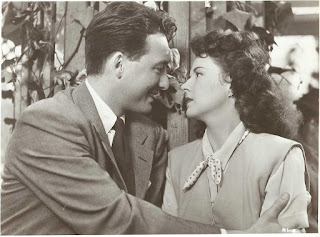Monday, October 05, 2015
Ida Lupino's "Outrage": the sexist banality of evil
"Outrage" (1950) on TCM, October 6, 2015 at 09:45 PM - A young woman who has just become engaged has her life completely shattered when she is raped while on her way home from work. Director: Ida Lupino, Producer: Collier Young, Screenplay: Collier Young, Malvin Wald & Ida Lupino, Cinematography: Archie Stout, Louis Clyde Stoumen, Cast: Mala Powers (Ann Walton), Tod Andrews (Bruce Ferguson), Robert Clarke (Jim Owens), Raymond Bond (Eric Walton), Lillian Hamilton (Mrs. Walton), Rita Lupino (Stella Carter).
In the documentary A Personal Journey with Martin Scorsese Through American Movies (1995) the influential director singles out the films that best define the dark and menacing genre of film noir. Among them is Ida Lupino's Outrage (1950), a film that has none of the usual noir trappings of murder, gunplay and bank heists. It is, instead, a personal tale of one woman's attempts to cope with the psychological effects of having been raped. In Scorsese's words, the film is "a subdued behavioral study that captures the banality of evil in an ordinary small town," not exactly how one normally defines noir. And few films captured the post-WWII zeitgeist of noir more effectively than Outrage.
Working late to earn extra money for her upcoming marriage, Ann Walton (Mala Powers) is stalked one night by the proprietor of a snack wagon (Albert Mellen), whose previous efforts to flirt with Ann had been unsuccessful. Unable to identify her attacker, Ann attempts to resume a life of normalcy, but is unable to endure the curious stares of her neighbors and co-workers. In some ways, Outrage clearly bears the earmarks of noir. The stalking sequence is filled with the angular compositions and encroaching shadows that define the genre's visual form, yet Lupino avoids some of the typical methods of generating suspense. Instead of burying the scene under an overwrought orchestral score, the scene is largely silent, which only compounds the tension.
Once Ann is attempting to start her life anew, there is very little attention paid to the search for the culprit. In some ways this is another diversion from the conventions of noir, which tend to focus upon the machinations of crime and punishment. But equally important to the genre is the psychological torment and confusion that cloud its characters' perspectives. Ann's inner turmoil is just as engrossing as any criminal investigation would be, and Lupino clearly wants to show that capturing the rapist would do little to ease Ann's pain and confusion, which is likely to linger well after the closing credits have run.
Lupino's unwillingness to conclude the film with a trite happy ending that magically restores its characters to normalcy is one of Outrage's many special achievements. But escaping the conventionality of screen drama was one of Lupino's ongoing objectives as a writer/producer/director.
Ida Lupino named her production company Emerald Productions, after her mother, Connie Emerald. Her ambition was to produce films that broached subjects generally avoided by the Hollywood mainstream. In addition to Outrage's careful treatment of rape, Lupino's films addressed such unconventional topics as bigamy (The Bigamist, 1953), unwed motherhood (Not Wanted, 1949), polio (Never Fear, 1949) and even the corruption of sports (Hard, Fast and Beautiful, 1951). The slightly ragtag feel of Lupino's films, coupled with their often sensational subject matter, has caused Lupino to be recently dubbed "Queen of the B's." Source: www.tcm.com
“Outrage,” a Hollywood movie from 1950, looks intimately, painfully, and analytically at what we now know to call rape culture. It was directed by Ida Lupino, who is familiar as one of the hard-edged and worldly-wise actresses of the forties and fifties (I’d especially recommend “The Man I Love,” “On Dangerous Ground,” “While the City Sleeps,” and “The Big Knife”), but she was also one of the great directors of the time.
“Outrage” is a special artistic achievement. Lupino approaches the subject of rape with a wide view of the societal tributaries that it involves. She integrates an inward, deeply compassionate depiction of a woman who is the victim of rape with an incisive view of the many societal failures that contribute to the crime, including legal failure to face the prevalence of rape, and the over-all prudishness and sexual censoriousness that make the crime unspeakable in the literal sense and end up shaming the victim. Lupino’s camera moves slowly toward the floor and parts the dancers, leaving them behind and leaving Ann isolated, as the movie—and Ann herself—contemplate the incommensurable emotional distance that separates her, seemingly definitively, from the realm of regular lovers. Source: www.newyorker.com
Subscribe to:
Post Comments
(
Atom
)




















No comments :
Post a Comment